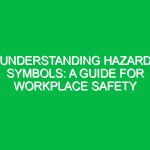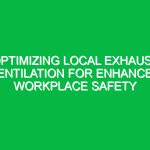Introduction
The “hierarchy of controls” is a systematic approach used in the Health, Safety, and Environment (HSE) domain to minimize or eliminate exposure to hazards. This framework is vital not only for regulatory compliance but also for fostering a safety culture within organizations. By prioritizing risk management strategies, companies can effectively protect their workforce and the environment while enhancing operational efficiency.
In essence, the hierarchy of controls serves as a roadmap for organizations to navigate through potential hazards. The concept is straightforward yet profoundly impactful: it dictates that the most effective way to reduce risk is to eliminate the hazard altogether. When that is not feasible, it guides users through various levels of control measures, from engineering solutions to administrative practices and personal protective equipment (PPE).
Understanding and implementing the hierarchy of controls is not just a theoretical exercise; it’s a practical necessity. This article will explore the various components of the hierarchy, the associated hazards, safety precautions, best practices, and relevant regulations that govern its application.
The Components of the Hierarchy of Controls
The hierarchy of controls is organized into five levels, each representing a different approach to managing risks. The levels, ranked from most to least effective, are:
1. Elimination
Elimination involves completely removing the hazard from the workplace. For example, if a task requires a hazardous chemical, replacing it with a non-toxic alternative would be considered elimination. This is the most effective method because it addresses the root of the problem.
2. Substitution
Substitution means replacing a hazardous material or process with one that is less dangerous. For instance, using water-based paints instead of solvent-based ones reduces the risk of inhalation and skin exposure to harmful chemicals.
3. Engineering Controls
Engineering controls refer to physical changes to the workplace that reduce or eliminate hazards. This could include installing ventilation systems to disperse airborne contaminants or using machine guards to protect workers from moving parts. These solutions are effective because they do not rely on human behavior to function properly.
4. Administrative Controls
Administrative controls involve changing the way people work. This might include implementing job rotation to limit exposure time to a particular hazard or developing comprehensive training programs that inform employees about the risks associated with their tasks. While effective, these controls depend heavily on compliance and can be less reliable than engineering controls.
5. Personal Protective Equipment (PPE)
PPE is considered the last line of defense in the hierarchy of controls. It includes items such as gloves, helmets, goggles, and respirators designed to protect workers from hazards. PPE is essential, but it should not be the primary method of hazard control, as it relies on proper usage and maintenance to be effective.
Identifying Hazards and Risks
Understanding the potential hazards associated with various tasks is critical in applying the hierarchy of controls effectively. Hazards can be classified into several categories, including:
Physical Hazards
Physical hazards include elements such as noise, radiation, and extreme temperatures. For example, in a manufacturing plant, workers may be exposed to high noise levels. In this case, engineering controls like noise barriers could be implemented, followed by administrative controls such as mandatory hearing conservation programs.
Chemical Hazards
Chemical hazards arise from exposure to harmful substances, be it through inhalation, ingestion, or skin contact. A real-world example can be found in laboratories where hazardous chemicals are handled. Implementing fume hoods and using safer substitutes can effectively mitigate these risks.
Biosocial Hazards
Biosocial hazards involve risks associated with biological agents, such as bacteria and viruses. In healthcare settings, for instance, exposure to infectious diseases can be a significant concern. Employing strict hygiene protocols and providing appropriate PPE can help manage these hazards effectively.
Ergonomic Hazards
Ergonomic hazards occur when the physical demands of a job do not match the capabilities of the worker. For example, repetitive strain injuries can result from prolonged periods spent at poorly designed workstations. Ergonomic assessments and redesigning workspaces can alleviate these issues.
Safety Precautions and Best Practices
To effectively implement the hierarchy of controls, organizations must adopt specific safety precautions and best practices. Here are several actionable strategies:
Conduct Regular Risk Assessments
Organizations should perform regular risk assessments to identify potential hazards and determine which level of control is necessary. This proactive approach allows for timely interventions before incidents occur.
Incorporate Employee Training
Training is essential for ensuring that employees understand the hazards they may face and the controls in place to protect them. Regular training sessions can reinforce safe practices and ensure compliance with safety protocols.
Encourage Reporting and Feedback
Fostering an environment where employees feel comfortable reporting hazards or near misses is crucial. This feedback can provide valuable insights into the effectiveness of the existing controls and highlight areas for improvement.
Utilize Signage and Labels
Clear signage and labeling can communicate hazards effectively. For instance, using bright colors and easy-to-read fonts can help alert workers to potential dangers in specific areas.
Regular Maintenance of Controls
Engineering controls and PPE must be regularly maintained and inspected to ensure they function effectively. Establishing a maintenance schedule can aid in identifying issues before they become serious problems.
Regulations and Standards Governing the Hierarchy of Controls
The hierarchy of controls is not just a best practice but is often reinforced by regulations and standards in various industries. Here are a few significant ones:
Occupational Safety and Health Administration (OSHA)
OSHA provides guidelines that incorporate the hierarchy of controls in workplace safety. Their regulations require employers to implement feasible measures to protect workers from recognized hazards.
National Institute for Occupational Safety and Health (NIOSH)
NIOSH conducts research and makes recommendations aimed at preventing work-related injuries and illnesses. Their guidelines emphasize the importance of using the hierarchy of controls in risk management strategies.
ISO 45001
The ISO 45001 standard for occupational health and safety management systems incorporates the principles of the hierarchy of controls, promoting a systematic approach to identifying and managing workplace hazards.
Conclusion
The hierarchy of controls is a foundational framework in the HSE domain that assists organizations in systematically managing risks. By prioritizing elimination, substitution, engineering controls, administrative controls, and PPE, businesses can significantly enhance their safety strategies.
However, the implementation of this hierarchy requires a concerted effort, including regular risk assessments, employee training, and adherence to regulations. As industries evolve and new hazards emerge, organizations must remain vigilant and adaptable, continually refining their approaches to health, safety, and environmental management. In doing so, they not only comply with legal requirements but also foster a culture of safety that protects their most valuable asset: their people.


